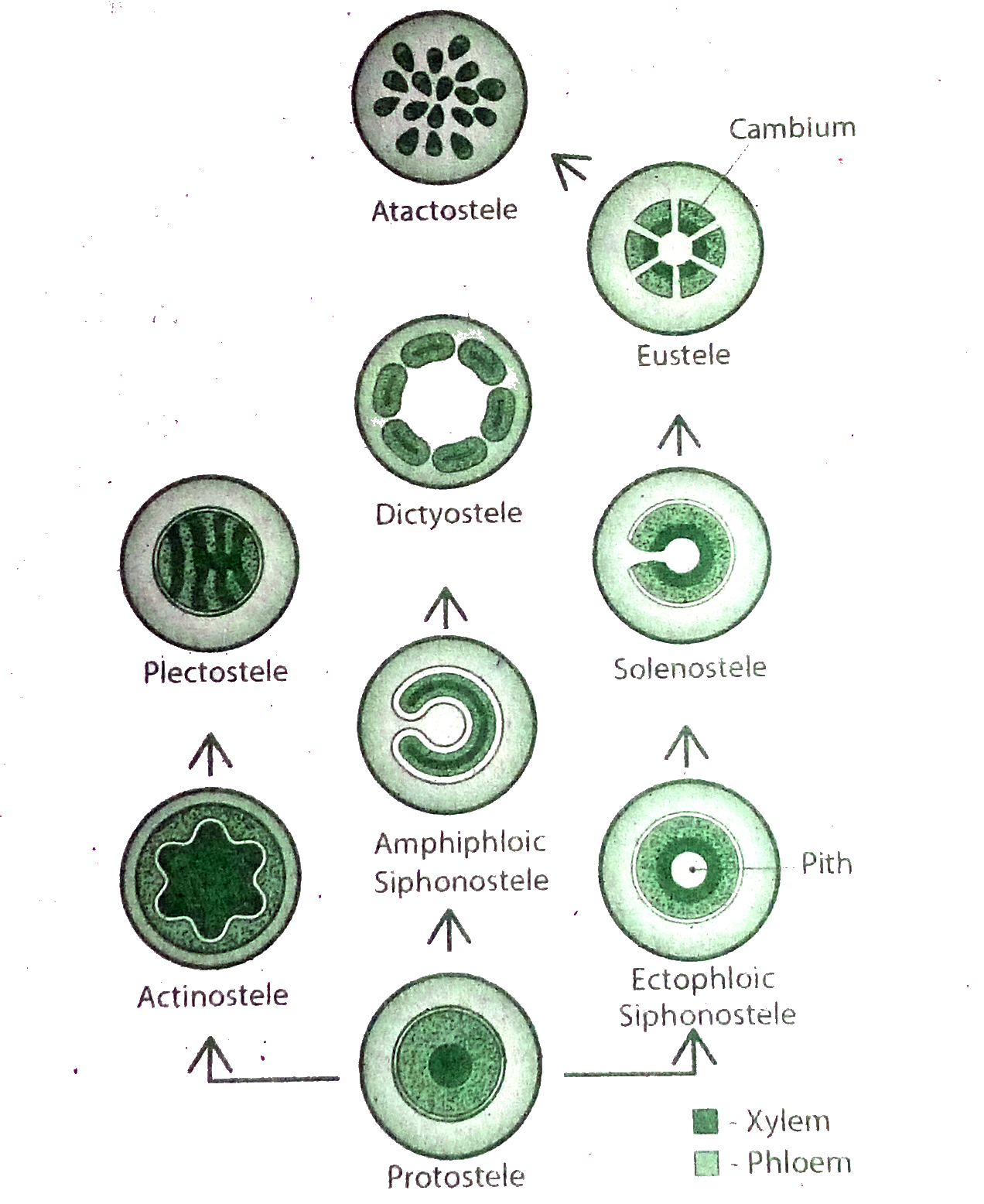Give an account of types of stelesSolution in Tamil
The term stele refers to the central cylinder of vascular tissues consisting of xylem, phloem, pericycle and sometimes medullary rays with pith. There are two types of steles (1) Protostele, (ii) Siphonostele
Protostele: In protostele xylem surrounds phloem. The type includes Haplostele, Actinostele, Plectostele, and mixed protostele
(1) Haplostele:Xylem surrounded by phloem is known as haplostele. eg. Selaginella
(ii) Actinostele: Star shaped xylem core is surrounded by phloem is known as actinosteleeg. Lycopodium serratum.
(iii) Plectostele:Xylem plates alternates with phloem plates, eg. Lycopodium clavatum
(iv) Mixed prototostele Xylem groups uniformly scattered in the phloem. eg. Lycopodium cernuum Siphonostele: In siphonostele xylem is surrounded by phloem with pith at the centre. It includes Fetophloic siphonostele, Amphiphloic siphonostele, Solenostele, Eustele, Atactostele and Polycylic stele. Ectophloic siphonostele: The phloem is restricted only on the external side of the xylem Pith is in centre. eg. Osmunda. () Amphiphloic siphonostele: The phloem is present on both the sides of xylem. The pith is in the centre. eg. Marsilea.
(ii) Solenostele: The stele is perforated at a place or places corresponding the origin of the leaf trace.
(a) Ectophloic solenostele: Pith is in the centre and the xylem is surrounded by phloem. eg. Osmunda.
(b) Amphiphloic solenostele: Pith is in the centre and the phloem is present on both sides of the xylem. eg. Adiantum pedatum
(c) Dictyostele: The stele is separated into several vascular strands and each one is called meristele. eg. Adiantum capillus-veneris.
(iv) Eustele: The stele is split into distinct collateral vascular bundles around the pith eg. Dicot stem.
(v) Atactostele: The stele is split into distinct collateral vascular bundles and are scattered in the ground tissue. eg. Monocot stem
(vi) Polycyclicstele: The vascular tissues are present in the form of two or more concentric cylinders. eg. Pteridium

Topper's Solved these Questions
- PLANT KINGDOMBOOK - PREMIERS PUBLISHERSCHAPTER - PLANT KINGDOMEXERCISE - OTHER IMPORTANT QUESTIONS S ANSWERS( Answer in brief)
10 Videos
- PLANT GROWTH AND DEVELOPMENT BOOK - PREMIERS PUBLISHERSCHAPTER - PLANT GROWTH AND DEVELOPMENT EXERCISE - OTHER IMPORTANT QUESTIONS & ANSWERS (ANSWER THE FOLLOWING) (5 MARKS)
8 Videos
- REPRODUCTIVE MORPHOLOGYBOOK - PREMIERS PUBLISHERSCHAPTER - REPRODUCTIVE MORPHOLOGYEXERCISE - SOLUTION TO ACTIVITY
1 Videos
Similar Questions
Explain in detail about the various life cycle patterns in plants.
View SolutionDescribe the geometric growth rate in plants with sutable diagram.
View SolutionPrepare a diet chart to provide balanced diet to an adolescent (a school going child) which includes food items (fruits, vegetable and seeds) which are non - expensive and are commonly available.
View SolutionThe most primitive type of stele is
View SolutionAssertion. Protostele is the simplest stele
Reason. Dictyostele is th most advanced type of stele
View SolutionWrite down the different types of steles.
View SolutionGive an account on respiration types of bacteria.
View SolutionType of stele seen in Marsilea is ………………. .
View SolutionDefine Stele & mention its types.
View SolutionWhich type of stele is found in sunflower root ?
View SolutionGive an account on types of epithelia.
View SolutionGive an account on the types of animal tissue.
View SolutionSimplest type of stele is
View Solution_____________ type of stele is present in monocots
View SolutionIn dicots which type of stele is present
View SolutionWhat are the two main types of stele?
View Solution
